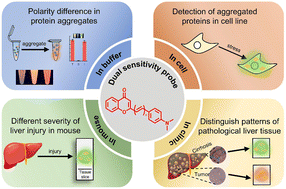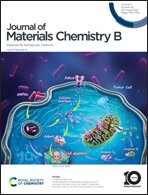Solvatochromic sensors detect proteome aggregation in stressed liver tissues with hepatic cancer and cirrhosis†
Abstract
Protein misfolding and aggregation involve complex cellular processes with clinical implications in various diseases. However, the detection of aggregated proteomes without defined 3-D structures in a complex biological milieu is challenging. This study utilizes chromone scaffold-based environment-sensitive fluorophores P1 and P2 to detect misfolded and aggregated proteome in stressed liver cells and the liver tissues diseased patients. The reported crystallization induced emission probes (P1 and P2) exhibit both polarity and viscosity sensitivity, with emission intensity and wavelength linearly correlated to viscosity and polarity. Meanwhile, P1 and P2 selectively and generally fluoresce upon binding to various aggregated proteins. In hepatic cells, P2 outperforms P1 in detecting stress-induced global proteome aggregation. In mouse liver tissue upon drug-induced injury, the fluorescence intensity of P2 correlated with the severity of liver injury, serving as an earlier indicator for liver stress prior to ALT/AST increase. The quantification of emission wavelength reveals lower micro-environmental polarity in liver-injury tissue. In patient-derived tissues with hepatic cancer and cirrhosis, P1 and P2 also report on the presence of aggregated proteome. Together, the reported solvatochromic proteome aggregation sensors can detect hepatic proteome aggregation and analyze its local polarity in cultured cell lines, animal model tissues, and human clinical samples.

- This article is part of the themed collection: 2023 Journal of Materials Chemistry B HOT Papers


 Please wait while we load your content...
Please wait while we load your content...